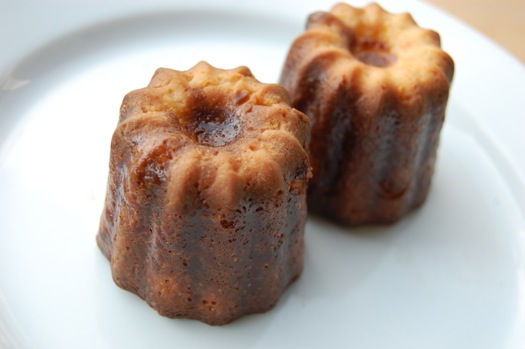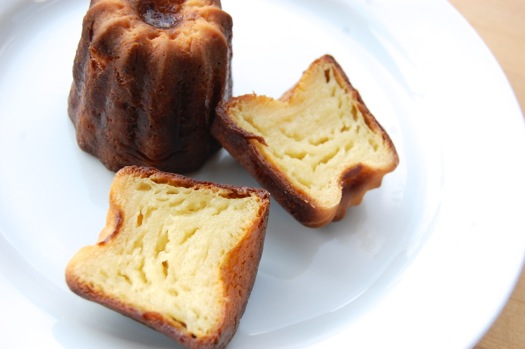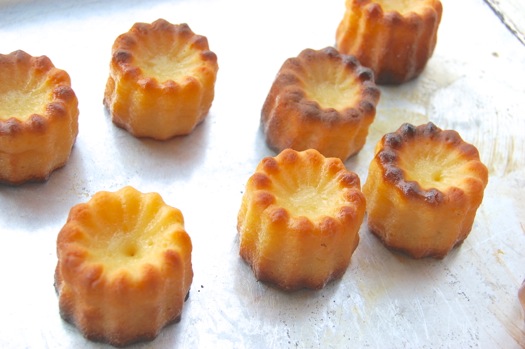Cannelés Attempt 1

So here’s what happened with the first attempt. They came out looking good, at least the ones baked in the copper molds. The were dark, shiny (yes, I used beeswax, reader June!) and very crunchy on the exterior. It’s the inside that didn’t work for me. Too custard-y and wet. See those holes? They’re flat bubbles where the batter rose then collapsed under its own weight. Not enough structure to hold them up.

Mrs. Pastry loved these as they reminded her of her time in the Peace Corps in the Dominican Republic. There they make sweet baked custards they call “arepas” that taste almost exactly like this: very sweet and crunchy on the outside and soft on the inside. But that’s not really my cup of tea. I don’t like the heaviness of these. I need more structure and a lighter crumb, so, on to the next version. Oh, and the ones I baked in the silicone molds were even less inspiring:

Not horrible but not something I’d go out of my way to eat, either. We’ll see what we can do to improve all this.
The ones in the top photo look great, you can practically taste the textural difference of crunchy outside to creamy inside. Would an initial higher heat have prevented the batter’s collapse, or is the issue elsewhere?
Hey Chana!
I think it’s a couple of things, mostly a lack of a structure: activated gluten, gelatinized starch and egg white. The heat would have expanded it, but it would need the structure to keep it standing once the bubbles formed. I’ll need to address that, I think!
– Joe
You’ve probably already come across this, but in case you haven’t I thought I would share. I haven’t made them (no molds), but it is very thorough and might have a tip or two that helps.
http://chezpim.com/bake/canele-recipe-method
Hey Deanna!
I have seen that, and indeed it was helpful. I’ve used several of her tips. I appreciate you helping to look out for my psychological welfare!
– Joe
When looking at Pim’s nearly perfect silicone versions, I couldn’t help but think that the light band around the middle might have been because the molds are connected at the top. I thought if she had cut apart the silicone into individual molds and spread them out, they might have colored more evenly. However, they may not have been able to stay standing like that…
Very interesting. Thanks, Catherine!
– Joe
Joe, an out-of-the-box thought – having dealt with other kinds of materials, one of the ways to get the bubbles to rise out of a slurry is to use a vibration. I did a quick search, and it’s apparently a common technique for chocolatiers. Do you think something similar would work with getting the bubbles out of this recipe? That would allow you to be a little more vigorous in your mixing, creating the gluten chains and such, while ending up with a low-bubble mix at the end.
[And that might be completely unworkable, but the idea of putting it on a 60 Hz vibration table while ‘resting’ for an hour seems like an interesting option]
That’s an excellent idea, and one I’ve seen employed in some recipes I’ve found. I shall employ it! Thanks very much, Roger!
– Joe
Hi Joe,
Looking at the difference between the copper and the silicone molds, I’m curious why copper and silicone are the only options. The goal seems to be a mold that maintains high heat levels and promotes browning. Shouldn’t, say, a ceramic or heavy duty dark metal mold work too, at a much reduced cost? Do they make such a thing?
Thanks!
Hey Mari!
In France you can get aluminum ones. So far I haven’t found any available on this side of the pond. I think there just isn’t a market here as cannelés are so obscure!
– Joe
I read this great quote somewhere about how “reading science fiction and reading recipes have one thing in common. You get to the end and think ‘Well, that’s never gonna happen’.”
This is pretty much how I’m feeling about my making these cannelés thingies.
LOVE that, Ted, and I shall use it at the soonest opportunity. I’ve heard the same thing about complicated recipes and porn. At home, neither work.
Cheers,
– Joe
INTERESTING! The one’s baked in silicone would look closer (but not quite the same) if given more bake time. At least that has been my experience.
I think the bake time in silicone might be 25% greater (maybe even more) than copper. (I assume the majority of recipes are written for copper molds.) If a recipe says bake 1 hour I end up baking 15 to 30 minutes longer to get decent color in a silicone mold.
Re: the interior. I have to admit that I’ve never had a bakery cannele so I don’t know what the center really is supposed to be like. But the ones I bake in silicone for long enough to get dark on the crown (bottom that becomes the top) have soft, silky, but not wet centers. I like it that way and hope that is “correct”.
I’m a big fan of your experiementationoand, once again, thank you for sharing all of you exploits.
Hey Brian!
I appreciate that. Also I have no idea what a real one is like, either. However I’m curious to see if I can achieve a more open crumb. I’d like them better that way, I think. We’ll see if I can achieve it!
– Joe
interesting. I confess that when you posted that you were going to test my idea first, I felt some anxiety that the result might have been even worse!
In hindsight, my analogy fails to account for how the dynamics of baking a batter are more complex than cooking a steak.
That may be true, but it was still an excellent idea — and it worked!
– Joe